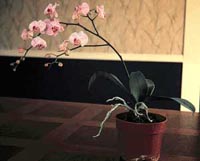Resource Library
Plant of the Week: Orchid, Moth
The University of Arkansas System Division of Agriculture does not promote, support or recommend plants featured in "Plant of the Week." Please consult your local Extension office for plants suitable for your region.
Plant of the Week
Moth Orchid
Latin: Phalaenopsis ‘Doris'

Orchids are back! To the orchid specialists they’ve never been away, but to the average gardener orchids disappeared from the nursery trade about the time General Motors decided it was no longer cool to have tail fins.
Today, because of developments in propagation and high volume distribution through the home improvement stores, we’re seeing orchids offered throughout the year.
Most of the big-box retailers are offering an assortment of orchid species, but one of the most beautiful and easy to grow is the moth orchid. Phalaenopsis is one of the epiphytic orchids that in nature resides in the tops of trees clinging precariously to a limb. It’s native to southeast Asia, with many species found on the Malaysian Peninsula.
It has leathery, strap-shaped leaves about 8 inches long. It lacks the swollen pseudo-bulb found in many of its epiphytic kin. The flowers are produced throughout the year on 2-3 foot long arching stems. They open sequentially from the base to the apex over about three months time.
The flowers are about 3 inches across and usually come in shades of pink or white. The lower lip is small in comparison to two large petals that are arranged opposite each other and give the general impression of a moth in flight.
The discovery of the first Phalaenopsis orchid was a result of the spice trade. A 25-year old clerk with the Dutch East Indies Company was stationed on the spice island of Ambon off the coast of New Guinea in 1653 when he began collecting plants from the wild. One of the plants was P. amabilis, which was finally published about a century later, but under a different name.
The task of defining the genus according to modern standards fell to the tyrannical German botanist Karl Blume (1796-1862) who, working in Holland, tried to maintain a monopoly on all of the botanical herbarium specimens coming out of that part of the world.
The Phalaenopsis grown today are nearly all hybrids, a practice that began with zealous fervor about the middle of the 19th century in Europe and is continued today by both hobby and commercial breeders.
Gardeners interested in learning more about orchids should attend the Arkansas Flower and Garden Show at the Little Rock Convention Center March 2, 3 and 4. Hermann Pigors, an orchid hybridizer and grower from the Chicago area with over 40 years experience, will speak at 1 p.m. Saturday, March 3. He’ll explain the intricacies and delights of orchid growing.
Phalaenopsis orchids are great buys, at least as flowers go. While many might consider the $25 price a bit on the steep side, the flowers routinely last for two to three months. Given their long period of bloom, a pot of orchids is much more economical than a weekly bouquet of cut flowers.
And given reasonable care, it’s possible to get moth orchids to rebloom. In fact, of all the orchids, Phalaenopsis is considered one of the easiest for the novice grower. The plants should be located where they get bright light but not direct sun. They should be grown in a coarse fir bark potting medium to insure the plants always have good drainage. But don’t let the medium get bone dry.
A monthly application of liquid fertilizer during the summer will keep plants growing and help them set another flower spike.
After the bloom fades, the spike should be removed and the plant relocated to a warm, bright location. In the summer, they can be moved to the shaded patio. Given routine fertilization and care, they should bloom again come fall.
By: Gerald Klingaman, retired
Extension Horticulturist - Ornamentals
Extension News - February 16, 2001
The University of Arkansas System Division of Agriculture does not maintain lists of retail outlets where these plants can be purchased. Please check your local nursery or other retail outlets to ask about the availability of these plants for your growing area.